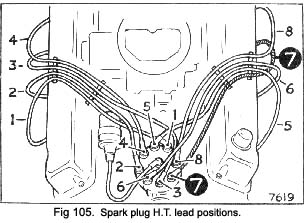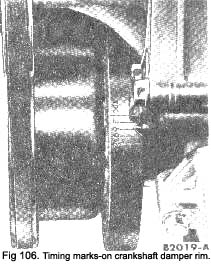IGNITION TIMING
The engine is very sensitive to ignition timing. Incorrect ignition timing will cause any one or more of the following faults.
Bad Idling.
Unsatisfactory performance.
High fuel consumption.
Overheating.
Rough or harsh running.
Distributors have different advance characteristics and it is most important that the correct distributor is used when a replacement unit is fitted. The possibility of a wrong unit having been fitted previously in service must not be overlooked. Full particulars of the dis-tributor are given in the Data Section.
The ignition timing should be checked with a strobos-copic timing lamp with the engine Idling at a speed of 500 r.p.m. The crankshaft damper rim has five timing marks ranging from T.D.C. to 12 deg. B.T.D.C. spaced at 3 deg. intervals. See Fig. 106.
Before checking the ignition timing the contact breaker dwell angle (or gap) should be checked, and if necessary correctly set. This will ensure that the correct Ignition timing is obtained each time the contact points are cleaned and adjusted.
The static ignition setting, contact breaker dwell angle, _ and gap are given In the Data Section under Ignition.
Dwell angle is the period in degrees during which the contact breaker points are closed.
|
Checking ignition setting
- Disconnect the vacuum feed pipe to the distributor at its most convenient end.
- Clean and paint the fixed T.D.C. pointer and the static ignition setting before T.D.C. with a thin white line on the crankshaft damper rim. Quick drying white paint should be used.
- Connect a timing light to number one spark plug. DO NOT PUNCTURE THIS H.T. LEAD. A suitable adaptor MUST be used between the end of the H.T. lead and No. 1 plug lead position in the distributor cap.
|
 **
**

